Story at a glance:
- MSR Design is repurposing Pittsburgh’s Mill 19 to create a vibrant space as part of a neighborhood centered around green energy.
- The design firm kept the external structure of the old industrial steel mill while building updated interior spaces.
- Public outdoor spaces are carefully landscaped with native, wild plantings that recall Pittsburgh’s history.
In 1883 Jones & Laughlin Steel Company built its first plants along the Monongahela River in Pittsburgh. The resulting factories, massive in scale and occupying acre upon acre, employed the thousands of workers who turned Pittsburgh into Steel City.
More than 130 years later advanced manufacturers operate on that same land. Carnegie Mellon University researchers pursue the latest in advanced robotics technology at a site that once paved the city’s industrial heyday.
From precision welding robots that improve steel workers’ safety to a robotic spraying system to disinfect warehouses exposed to COVID-19, innovation forges ahead on this historic site. While the smokestacks are gone, the spirit of industry pushes on.
The former J&L property is now known as Hazelwood Green, a 178-acre site in southeast Pittsburgh. After flourishing in the early 20th century, decades of decline culminated in the last steel plant ceasing operations in 1997. Today the land is owned by a partnership of several prominent Pittsburgh foundations, with remediation work and specific projects owned by the Regional Industrial Development Corporation, or RIDC. It’s a unique blend of old and new Pittsburgh, says City Councilman Corey O’Connor, and one with a strikingly forward-looking vision.
“It’s a whole neighborhood we’re building around clean, green energy,” says O’Connor, whose district includes Hazelwood Green, which is the largest mixed-use development in the city.
Riverfront access is one critical aspect of the new development. Despite its proximity, the Monongahela River has long been out of reach for neighborhood residents. A 1.3-mile stretch of the riverfront will be revitalized as part of the development, complete with industrial artifacts reflecting the site’s history, from a pump house to coal loaders and catwalks.
In addition to trails and public space, the massive development will feature office, retail, and residential buildings with a mix of densities. At the very southernmost end, Uber operates a test track for its autonomous vehicles.
Repurposing the Mills
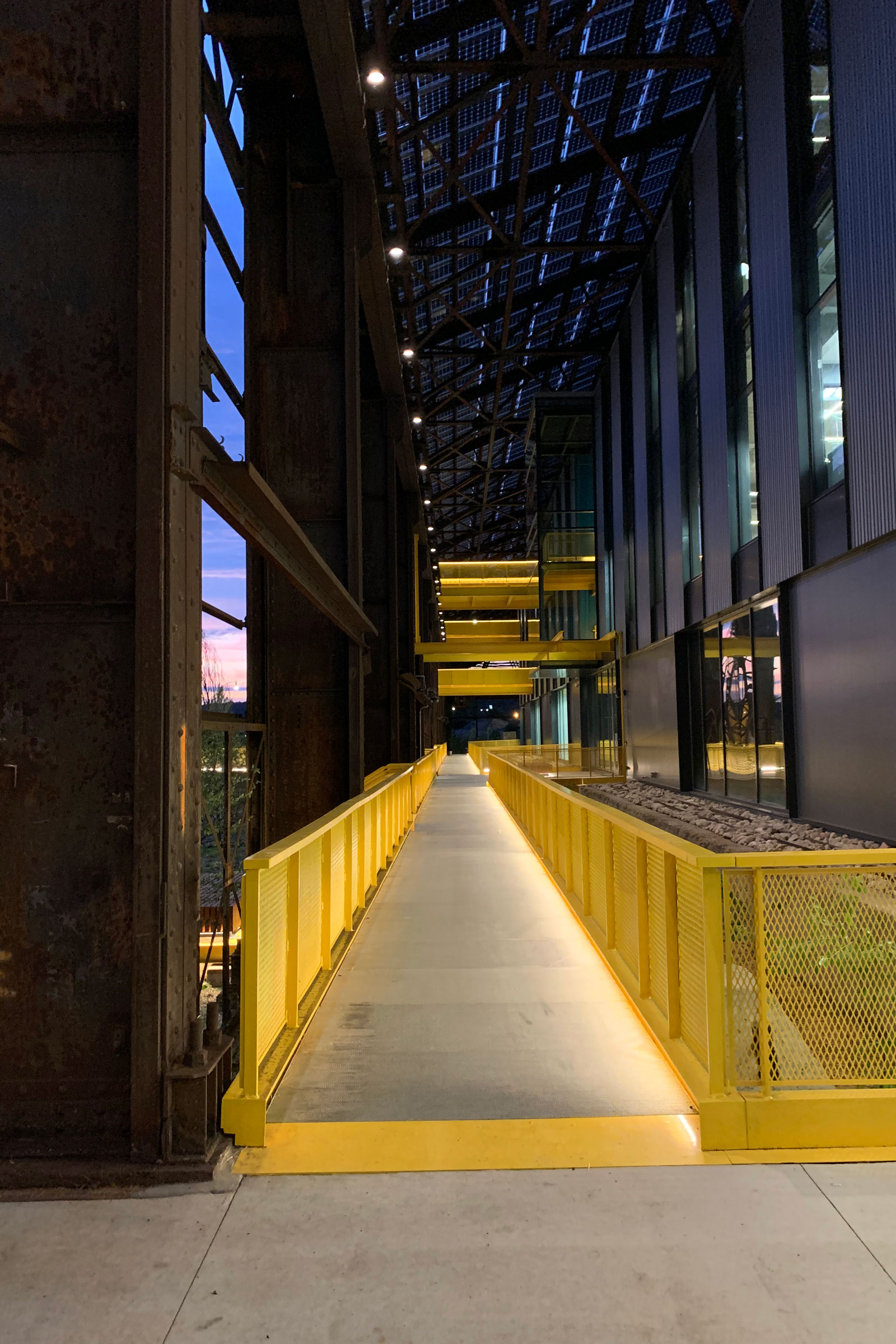
Courtesy of Ten X Ten
The advanced manufacturing researchers work on this historic site thanks to Mill 19, one of the marquee projects within the development. While most of the original buildings were torn down as part of substantial remediation to the brownfield, the three former rolling steel mills that now make up Mill 19 were preserved.
The steel superstructure remained for good reason, according to Dan Vercruysse, senior associate at project architect MSR Design. Not only do the original site buildings connect new tenants to Pittsburgh history, they also have the attributes that today’s manufacturers are looking for, like high bays. The trick, however, was finding a way to meet the project’s intensive sustainability goals in such an enormous space.
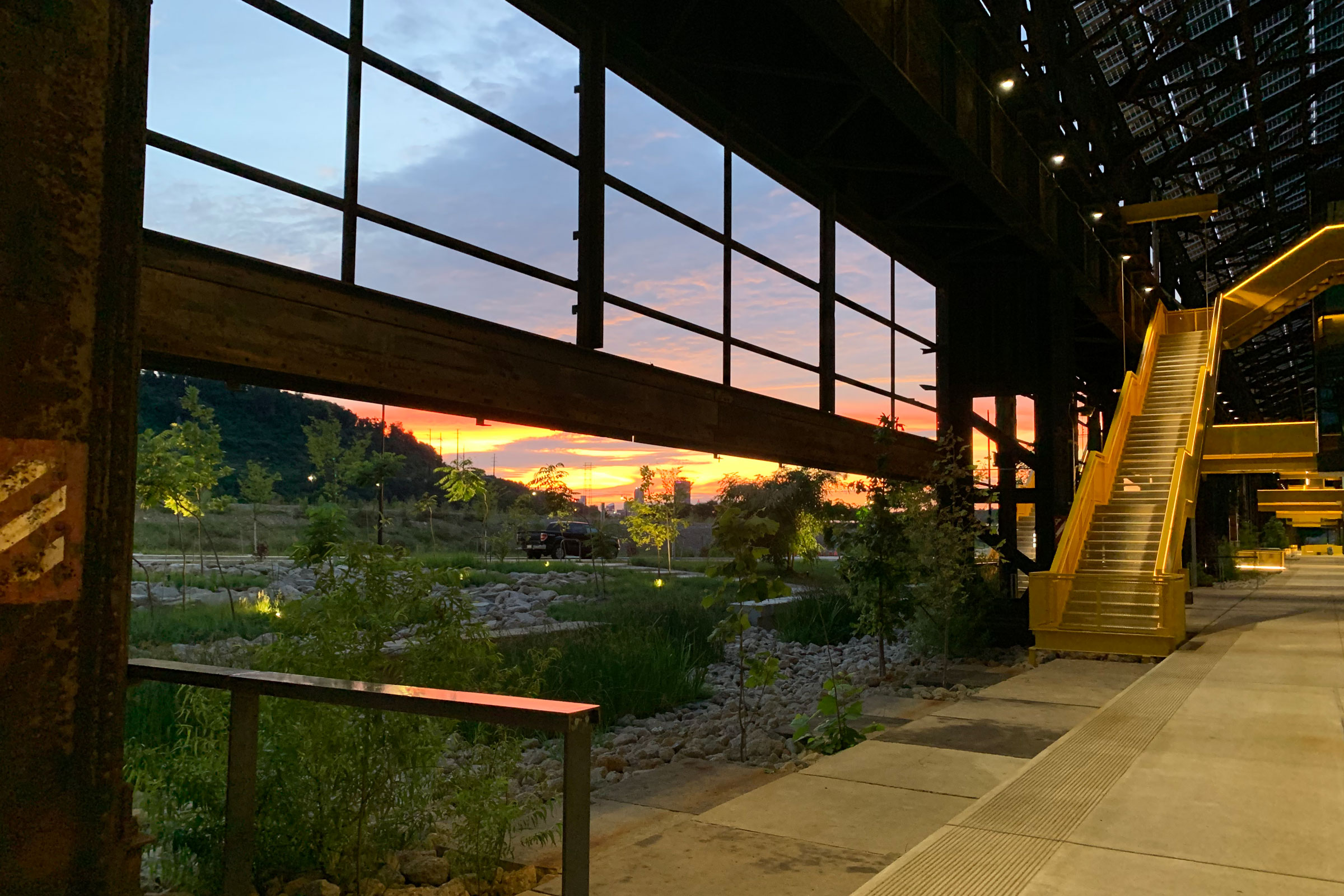
Courtesy of Ten X Ten
That’s where the big idea came in, Vercruysse says: They would create new buildings within the mills’ original bones. The corrugated metal walls were removed, the concrete slab broken into three grades of filler to be used in the landscape, and a 21st-century mill was built from the ground up.
MSR, a Minneapolis-based firm with experience transforming industrial structures into sustainable and modern spaces, led the overhaul at Mill 19. The firm won accolades for its transformation of what was once the largest flour mill in the world into the Mill City Museum along the Minneapolis riverfront. The first three-story building at Mill 19 opened in September 2019, and the second and third are in development.
Energy for the Future
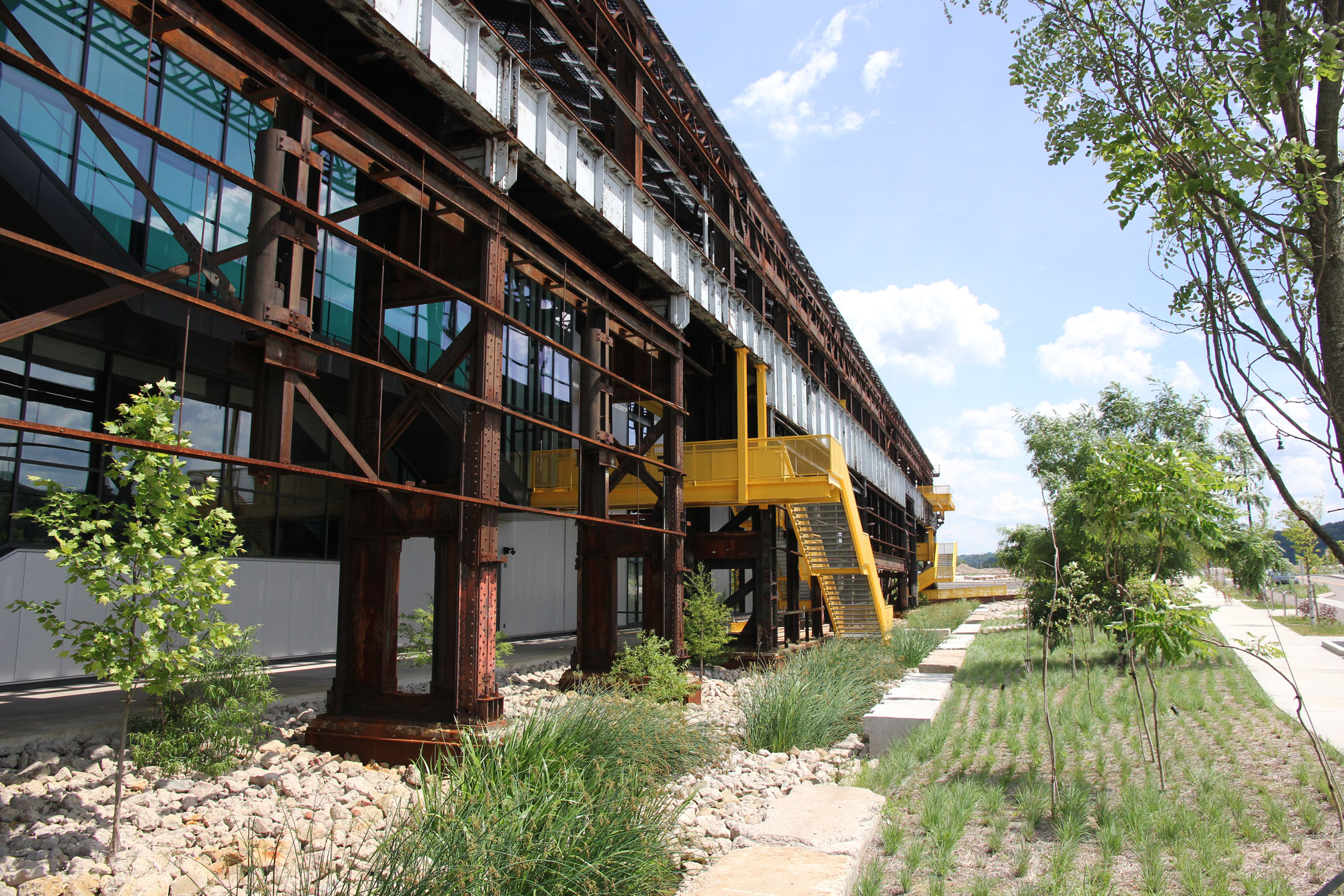
Photo by Jeryl Aman, MSR Design
When you arrive at Mill 19 you see how the site blends old and new. As you approach you pass a PV array and cross a platform where the old rail line cut through. Every aspect of the site is designed with long-term sustainability in mind, achieving LEED Gold certification and near net-zero energy usage.
With nearly 5,000 silicon panels, the solar installation is the largest in Pittsburgh history—and the largest sloped-roof installation in the country. RIDC placed a high value on sustainability, says Don Smith, president of RIDC. “Given the future-looking orientation of our target tenants, it was even more important for us to incorporate the latest advances in renewable energy, water efficiency, and energy efficiency,” he says.
Smith says Mill 19 is the poster child for Pittsburgh’s future. “It reflects the industrial heritage and work ethic of our region and its role in the industrial age,” he says. “Yet its buildings and, more importantly, the tenants it is designed to accommodate, represent the emerging innovation industries that account for the bulk of our region’s current growth, as well as the brightest prospects for defining Pittsburgh’s future economic success.”
An Industrial Landscape, Transformed
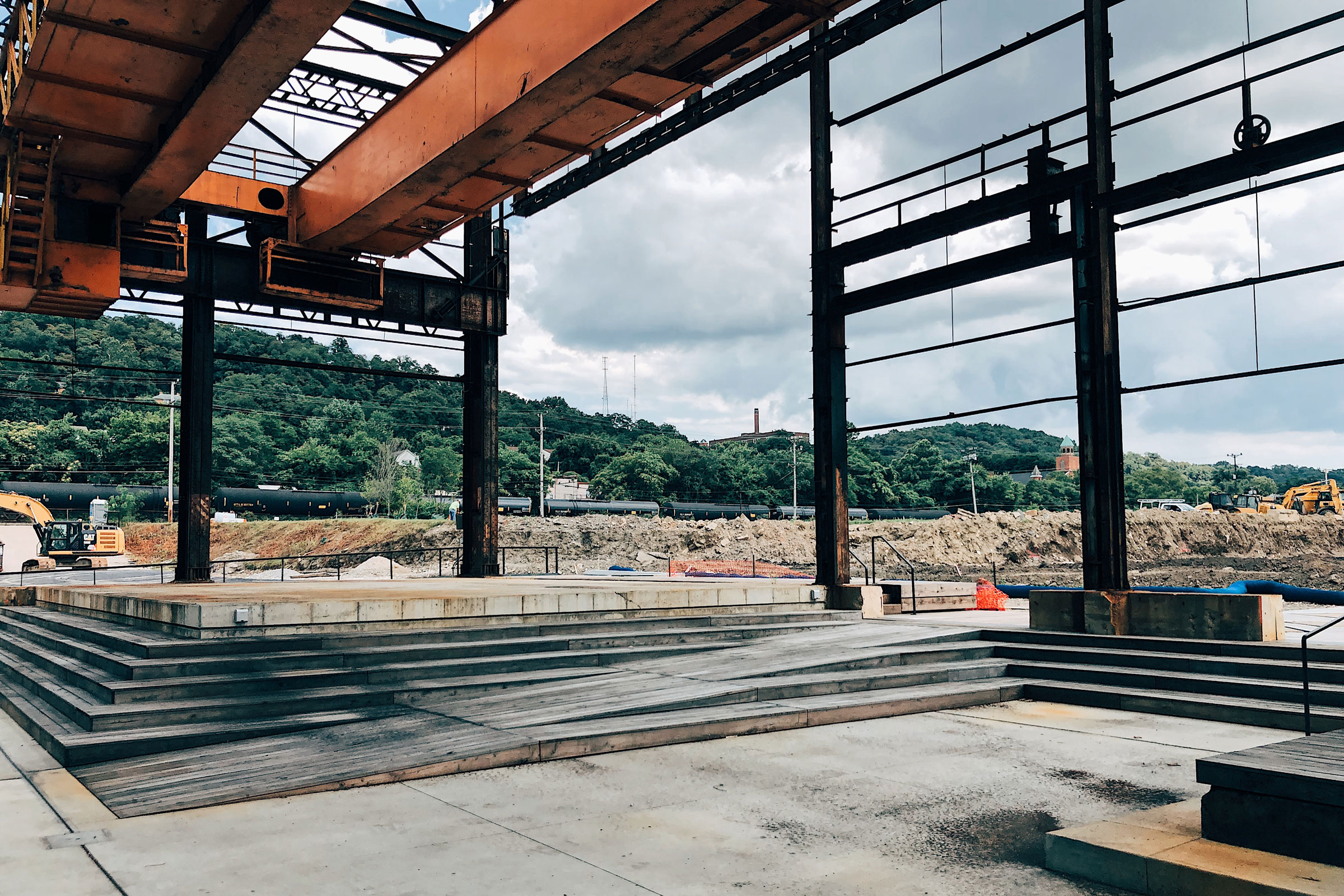
Courtesy of Ten X Ten
From the beginning the development of Mill 19 wasn’t focused exclusively on the buildings. The site itself is a welcoming public space. As you walk alongside the building, the path you’re on rises and falls with the land, offering a vista of the native plants and grasses populating the site. “It’s a nice public space on private land,” says Jeryl Aman, architect and associate at MSR.
Among the site’s public amenities is the South Porch, a gathering place with a stage for performances in a post-COVID future. On the porch, seating made from recycled steel beams and salvaged concrete showcases the project’s industrial character.

Rendering courtesy of Ten X Ten
The landscape design, led by Minneapolis-based TEN x TEN and D.I.R.T. Studio, a Virginia-based practice focused on urban regeneration, tackled multiple goals with gusto. For one, it had to manage the stormwater that came rushing down the hill. The team designed a rooftop collection system that gathers rainwater and channels it into a cistern, along with a stormwater filtration garden that marries form and function along the west side of the mill.
The landscape also evokes the site’s industrial past. Maura Rockcastle, principal of TEN x TEN, and her team transformed existing steel into outdoor benches and other furniture, and they subtly evoked the century-old site’s character in every element. “Let’s use as much of this magic as possible,” Rockcastle says of their mindset from day one. That led them to uncover alternatives to traditional building materials and landscape features, too. The original concrete slab, for example, became fill for retaining walls and other features throughout the landscape, preventing the team from bringing in quarried materials like limestone or granite.
“We loved the aesthetic and history and story of the site,” Rockcastle says. “We were committed to making a new design that didn’t erase that.” It raised some eyebrows with the TSA when they flew to Pittsburgh with a pound of clay, she laughs, but that clay proved essential to document the rugged texture of the site. After taking textural imprints across Mill 19, capturing the gritty aesthetic of the massive bolts and hardware, her team turned them into casts they used in furniture and other elements across the landscape.
The plantings themselves were inspired by what the TEN x TEN team found when they first arrived. Inside the mill, moss and ferns had taken over the shadowy spaces. Outside, poplars, catalpas, and sumacs grew wild, the seeds having flown in on a breeze or deposited by animals. The team evoked this wind-blown spirit with all the plantings, Rockcastle says. They didn’t want trees that were perfectly symmetrical—they wanted them a little bit on the wild side.
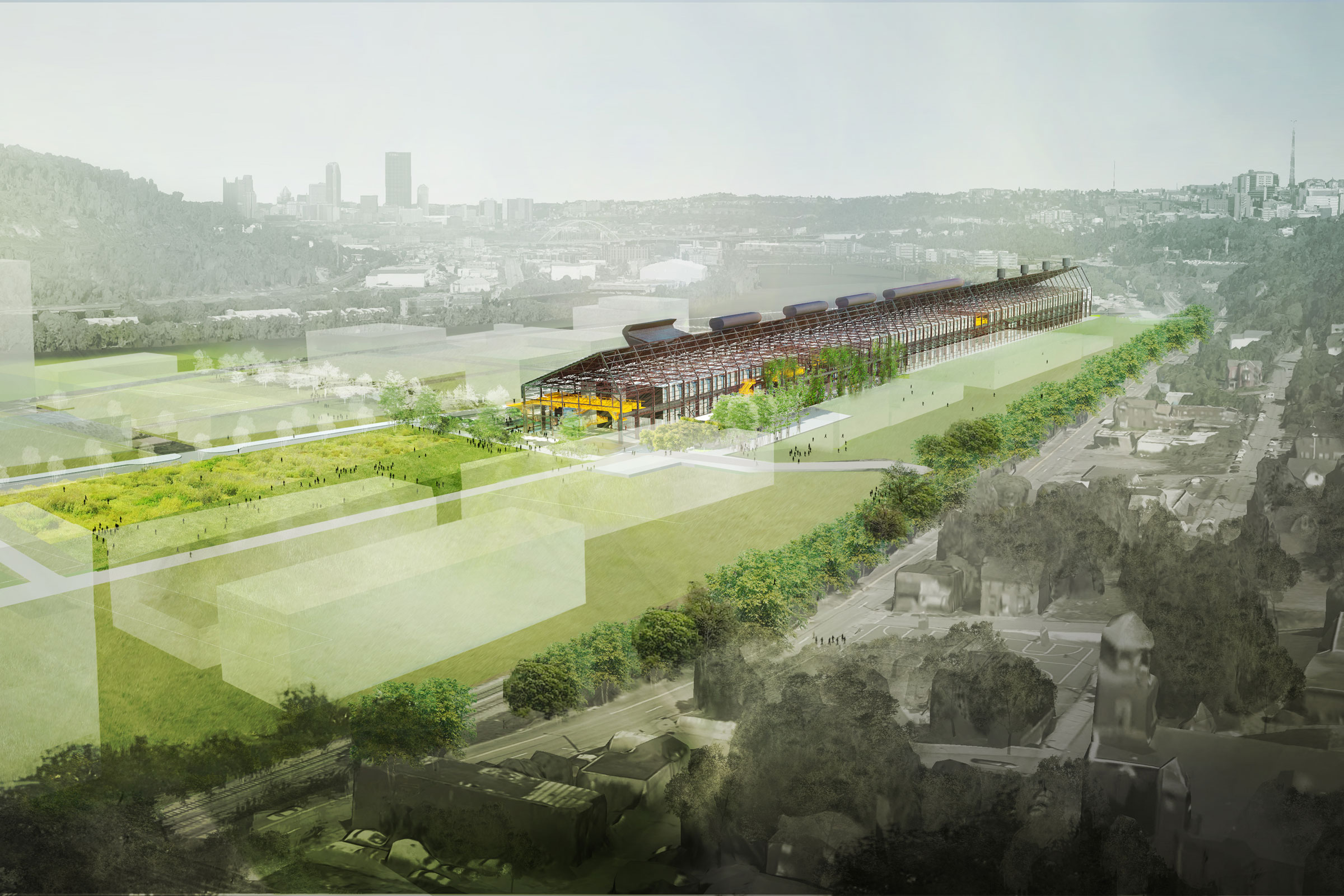
Rendering courtesy of Ten X Ten
“To have a site like this with such an incredible economic and social history of what Pittsburgh is, to come across it after it was vacant for so long, it was a dream for a landscape architect to work on a project like this, at this scale,” she says.
For the city, Mill 19 is just the beginning. As the work on phases B and C continues, which will transform two more segments of the original mill into multi-use space, and other aspects of Hazelwood Green come to fruition, the project represents the potential for green building, sustainable landscapes, and the jobs of the future.
To think that the manufacturers of the 21st century work on top of an old steel mill site—it forces O’Connor to pause and reflect. “It’s really unique and something to be proud of,” he says. “We’re leading the way when it comes to robotics and manufacturing, to help not only Pittsburgh and western Pennsylvania but the entire country to be part of that revolution.”
Project: Mill 19 at Hazelwood Green Architect: MSR Design Location: Pittsburgh, PA Size: 265,000 square feet Completion: ongoing Engineer: Bala Landscape Architects: TEN x TEN, D.I.R.T.


